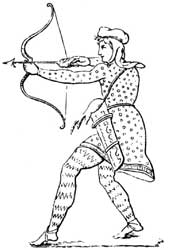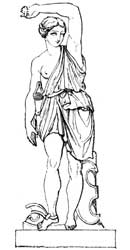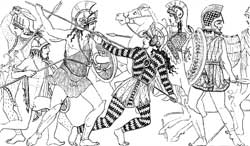Amazon
A warlike race of females, who act a prominent part in several of the adventures of Greek mythology. All accounts of them agree in the statement, that they came from the country about the Caucasus, and that their principal seats were on the river Thermodon, in the neighborhood of the modern Trebizond. From thence they are said to have at different times invaded Thrace, Asia Minor, the islands of the Aegean, Greece, Syria, Arabia, Egypt, and Libya.

The country about the Thermodon with its capital Themiscyra was inhabited only by the Amazons, who were governed by a queen. The Gargareans, a race of men, were separated from them by a mountain, but once every year the Amazons met the Gargareans in the mountains for the purpose of propagating their race, and then returned to their own country. Their children, when of the female sex, were brought up by the Amazon mothers, and trained in their customary pursuits of war, riding, hunting, and cultivating the land; but each girl had her right breast cut off: their male children, on the other hand, were sent to the Gargareans, or put to death.1
The principal gods they worshiped were Ares and Artemis Tauropolos. The foundation of several towns in Asia Minor and in the islands of the Aegean is ascribed to them, e.g. of Ephesus, Smyrna, Cyme, Myrina, and Paphos. Strabo doubts the existence of such a race of females, while Diodorus attempts to give an account of them, which assumes all the appearance of history. That the Amazons were regarded as a real historical race down to a late period, is evident from the tradition, that, when Alexander the Great approached the country of the Amazons, their queen Thalestris hastened to him, in order to become mother by the conqueror of Asia.2

But we confine ourselves here to noticing some of the mythical adventures with which the Amazons are connected. They are said to have invaded Lycia in the reign of Iobates, but were destroyed by Bellerophon, who happened to be staying at the king's court.3 At the time when Priam was yet a young man, they invaded Phrygia, and fought with the Phrygians and Trojans.4 The ninth among the labors imposed upon Heracles by Eurystheus, was to take from Hippolyte, the queen of the Amazons, her girdle, the ensign of her kingly power, which she had received as a present from Ares.5 In the reign of Theseus they invaded Attica.6 Towards the end of the Trojan war, the Amazons, under their queen Penthesilea, came to the assistance of Priam; but the queen was killed by Achilles.7
The question as to what the Amazons really were, or rather, what gave rise to the belief that there was such a race of women, has been much discussed by ancient as well as modern writers. Herodotus8 says, that in the Scythian language their name was Oiorpata, which he translates by ἀνδροκτόνοι (androktonoi). The Greek name Amazones is usually derived from mazos, the breast, and is supposed to mean "breastless," or "not brought up by the breast," "beings with strong breasts," or "with one breast."9 Others derive it from the Circassian word maza, said to signify the moon, or from Emmetch, which, according to a Caucasian tradition, is said to have been their original name.10

Among the various ways in which it has been attempted to account for the origin of the story about the Amazons, two deserve to be mentioned. One opinion is, that the peculiar way in which the women of some of the Caucasian districts lived, and performed the duties which in other countries devolve upon men, together with the many instances of female bravery and courage which are noticed as remarkable even by modern travelers, were conveyed to the inhabitants of western Asia and the Greeks in vague and obscure reports, and thus gave rise to the belief in the existence of such a warlike race of women, and that these rumors and reports were subsequently worked out and embellished by popular tradition and poetry.
Others think that the Amazons were originally priestesses of Artemis (the moon), whose worship was widely spread in Asia, and which they are said to have established in various parts. It is further inferred, from the name Amazones, that these priestesses mutilated their bodies by cutting off their breasts in a manner similar to that in which the Galli and other priests mutilated their bodies, and that thus the Amazons represented the male ideal in the female sex, just as the Galli represented the female ideal in the male sex. But it would be difficult, in the first place, to prove the existence of such priestesses, and in the second, to show how they could have occasioned the belief in a whole female race of this kind. Neither the poetical nor historical traditions about the Amazons contain anything to render this opinion very plausible; and, in the absence of all positive evidence, the first opinion has much more to recommend it.11
❧
Iconography
The representation of these warlike women occupied the Greek artists very extensively, and we still possess a large series of the most beautiful works of art, such as paintings on vases and walls, bronzes, reliefs, and gems, in which the Amazons and their battles with men are represented. The most celebrated works of this kind in antiquity were the battle of the Amazons with the Athenians in the Poecile at Athens, by Nicon,12 on the shield of Athena, and on the footstool of the Olympian Zeus, by Phidias.13 Amazons were also represented by Alcamenes in the pediment of the temple of Zeus at Olympia.14
The battle of the Amazons against the Greeks was a favorite theme in Greek art. On vases the Amazons are portrayed in Scythian cloths with cap and trousers. In the Stoa Poikile at Athens, Micon painted an Amazon battle (475 BCE). An attic kylix depicts the death of Penthesilea (460 BCE; Munich). The Apollo temple at Bassae (fifth century BCE) shows many Amazons, as well as the heroon at Gjolbaschi (fifth century BCE) and the Mausoleum of Halicarnassus (fourth century BCE). Four famous sculptors competed in creating an Amazon for the Artemis temple at Ephese: Crelisas, Phidias, Phradmon, and Polycletus (ca. 430 BCE). All these four sculptures depict a wounded Amazon.
In the Middle Ages, Renaissance, and baroque, the Amazon remained a popular subject, particularly the death of Penthesilea (Rubens, Jordaens, Giulio Romano, etc).
In art, the Amazons are always depicted with both breasts.
References
Notes
- Strabo. Geography xi., 503 ff.; Diodorus Siculus, ii, 45 ff.; iii, 52 ff.; Justin, ii, 4.
- Plutarch. Alexander, 46.
- Homer. Iliad vi, 186 ff.; Scholiast on Lycophron, 17.
- Homer. Iliad iii, 189 ff.
- Pseudo-Apollodorus. The Library ii, 5.9; Diodorus Siculus, iv, 16; Hyginus. Fabulae, 30; Quintus Smyrnaeus, xii, 244.
- Pausanias. Description of Greece i, 2; Plutarch. Theseus, 31, 33.
- Quintus Smyrnaeus, i, 669; Pausanias. Description of Greece v, 11.2; Philostratus. Heroicus xix, 19.
- iv, 110.
- Philostratus, l.c.; Eustathius on Homer, p. 402.
- Sprengel. Apologie des Hippocrates, ii., 597; Klaproth. Reise nach dem Caucasus, i, 655.
- Comp. Müller. Orchomenos und die Minyer, 356 ff.
- Pausanias. Description of Greece i, 15.2.
- ibid. i, 17.2.
- ibid. v, 10.2.
Sources
- Aken, Dr. A.R.A. van. (1961). Elseviers Mythologische Encyclopedie. Amsterdam: Elsevier.
- Smith, William. (1870). Dictionary of Greek and Roman Biography and Mythology. London: Taylor, Walton, and Maberly.
This article incorporates text from Dictionary of Greek and Roman Biography and Mythology (1870) by William Smith, which is in the public domain.